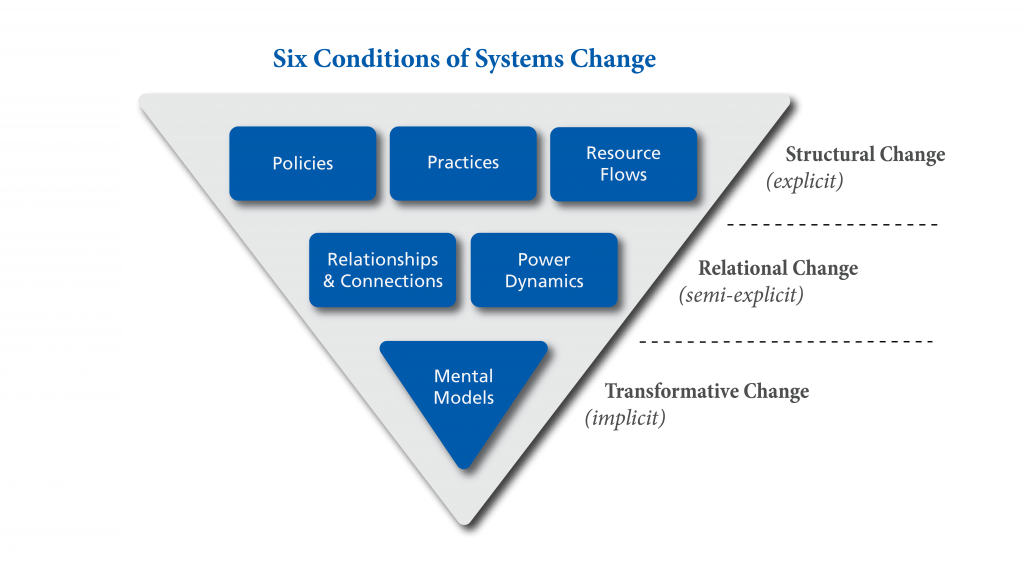The ultimate goal of the Movement is to bring community-led development to scale everywhere it is needed. This requires a profound systems change that will #ShiftThePower from central governments to local communities. We are guided in this part of our work to the framework articulated by Kania, Kramer and Senge (2018) in The Water of Systems Change.

As the authors point out, many groups focus just on the top level — writing brilliant papers on the Policies, Practices and Resource Flows required but ignoring the underlying systemic factors that give rise to them, beginning with a lack of a shared mental model.
Our mental model is subsidiarity — the recognition that human dignity depends on individual women and men having voice over the decisions that affect their lives — which in turn requires that decisions are made and accountability established at the level as close to people as is practical: primary schools and clinics at the community, colleges and hospitals at the district.
The next is Relationships and Connections. Systems change is most likely and most sustainable as a partnership between civil society and government. Our best pathway to #ShiftThePower is by establishing relationships of trust and mutual respect with policy makers who share our mental model. We find that field visits are an excellent strategy for creating relationships with policy makers: seeing is believing, and when sympathetic policy makers hear directly from community leaders as well as from other policy makers, they can become champions for the cause.
Power Dynamics: our best pathway here is for our champions within government to guide us through this minefield. For example, in Malawi, our champion within a ministry advised that a key step would be for the parliamentary oversight committee to come out and meet the same community.
Policies that must change for community-led development come in five key flavors:
- Administrative Decentralization — moving key public service providers and managers to the community level.
- Political Decentralization — ensuring that local officials are elected, not “appointed” from on high — and are directly accountable to local communities.
- Financial Devolution — ensuring that local communities can control a fair share of public resources. An emerging norm for this is at least 20%.
- Active Citizenry — policies for transparency, right-to-information and mandatory social accountability mechanisms.
- Multi-stakeholder planning — local infrastructure and resilience planning must have a life longer than one election cycle. Local planning processes need to include all stakeholders: women, youth, the private sector, local academics, ethnic and religious minorities as well as elected official.
Practices: In many low-income countries, the gap between the policies on the books and the actual practice is immense and often reflects the generally low expectations and hopelessness in the face of poor governance. Advocates need to analyze the source of this in order to be able to address it — is it simply lack of competence and skills? corruption? lack of timely data and clear lines of communication. Again, partnership among stakeholders can overcome entrenched defensiveness.
Resource Flows: Where the rubber hits the road is in resource flows. Is there transparency, accountability and timeliness? There are so many sad stories even in countries with strong fiscal devolution policies that those resources reach the community just one month before the deadline for them to be spent.
Analyzing and then swimming the water of systems change can only fully be done locally, and so the local chapters have a huge responsibility to — first — find their own shared understanding of the appropriate mental model for community-led development among themselves — and then work together to swim upstream with agility and endurance and restructure the system.
Feature photo: Sockeye salmon jumping up Brooks falls during their annual migration at Katmai National Park, Alaska – sekarb/istock.


